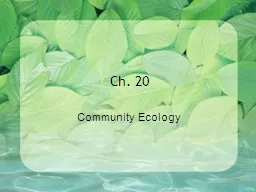

What is predation Predator eats prey What are three adaptations of predators What makes them good at finding capturing and consuming prey acute smell heat sensing pits venom sticky webs ID: 778005
Download The PPT/PDF document "Ch. 20 Community Ecology" is the property of its rightful owner. Permission is granted to download and print the materials on this web site for personal, non-commercial use only, and to display it on your personal computer provided you do not modify the materials and that you retain all copyright notices contained in the materials. By downloading content from our website, you accept the terms of this agreement.
Slide1
Ch. 20
Community Ecology
Slide2What is predation?
Predator eats prey
Slide3What are three adaptations of predators?
What makes them good at finding, capturing, and consuming prey?
acute smell
heat sensing pits
venom
sticky webs
teeth/mouthparts
camouflage
speed
Slide4List three adaptations of prey?
What makes them good at escaping, avoiding, or warding off predators?
fleeing
hiding
warning coloration
resembling something inedible
deceptive markings
chemical defenses
Slide5What is mimicry?
One species resembles another
Slide6What are the two types of mimicry?
Batesian – harmless species resembles a harmful one
Mullerian – 2 or more dangerous or distasteful species look similar
Slide7What are some plant prey adaptations?
Thorns, spines, sticky hairs, tough leaves, chemical defenses
Slide8Define interspecific competition
Two or more species using the same limited resource
Intraspecific
– same species competing
Interspecific
– different species competing
Slide9Competitive Exclusion
A species is eliminated from a community because of competition
Slide10What is symbiosis?
Close long-term relationship between two organisms.
3 types:
Parasitism (-/+)
Mutualism (+/+)
Commensalism (+/0)
Slide11Parasitism : one benefits (parasite), one is harmed (host)
Exp. fleas, ticks, tapeworms
Slide12Mutualism: both benefit
Exp. ants and acacia trees
Slide13Commensalism: one benefits, other is neither helped nor harmed
Exp. cattle egrets and cape buffalos, sharks and remoras
Slide14Patterns in Communities
Succession
Slide15What is succession?
Gradual sequential re-growth of a community.
Slide16Ecological succession
Gradual, sequential regrowth of a community
years or decades
usually after a disturbance
Mt. St. Helens
Slide17What’s the difference between primary and secondary succession?
Primary – no soil previously; area previously did not support life
Secondary – soil already intact; follows disruption of a pre-existing community
Slide18Primary succession
Begins with virtually lifeless area without soil, then…
bacteria
lichens & mosses
Once there’s soil, other plants can grow:
g
rasses
shrubs
trees
make
soil
{
Slide19When is primary succession likely to occur?
On bare rock
Sand dunes
After volcanic eruption
On concrete (like an abandoned parking lot)
Slide20What is a pioneer species?
First species in an area
Predominate early succession
Characteristics: small, grow quickly, reproduce quickly, disperse seed easily
Slide21What organisms are typically found in the early stages of primary succession?
Lichens – form soil
→
Grasses/weeds
→
Mosses
→
Eventually larger plants and finally trees
Large conifers may be found in the end stage of primary succession in northern latitudes (pines, balsams, spruces)
Slide22Secondary succession
Existing community cleared,
but base soil is still intact
burning releases nutrients formerly locked up in the tissues of tree
the disturbance starts the process of succession over again
Slide23When is secondary succession likely to occur?
After forest fires, strong storms, farming, logging, mining
Slide24Organisms found in early stages of secondary succession?
Weeds
→
Perennial grasses and shrubs
→
Hardwood trees eventually (deciduous forest)
Slide25Climax Community
Plant community dominated by trees
Representing final stage of natural succession for specific location
stable plant community
remains essentially unchanged in species composition as long as site remains undisturbed
birch, beech, maple,
hemlock
oak, hickory, pine